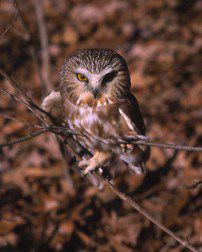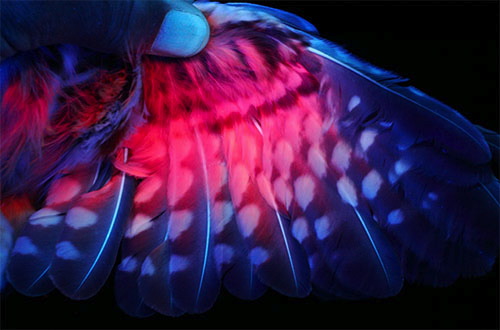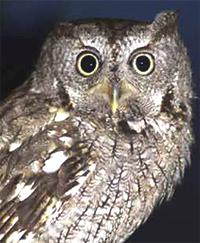HOME: www.hiltonpond.org |
|||
HOME: www.hiltonpond.org |
|||
- RESEARCH -
NORTHERN SAW-WHET OWL
Aegolius acadicus

All text, maps, charts & photos © Hilton Pond Center
Hatch-year Northern Saw-whet Owl (above)
In 1999, Hilton Pond Center for Piedmont Natural History became what was then the southernmost site in a national network using night-time banding to study dispersal of Northern Saw-whet Owls, Aegolius acadicus. This northern species breeds primarily in the northeastern and western U.S. and in southern Canada (green area on map below right) and overwinters mainly in the central U.S. and the Atlantic Coast states (blue area on map). As banding studies have expanded, winter banding records for these owls have increased for several southern states, including Alabama, Georgia, and South Carolina.
 Through October 1999, only four Northern Saw-whet Owls (NSWO) had ever been banded within South Carolina--the first in 1960 and the latest in 1972; none had ever been banded in South Carolina's Piedmont region. At Hilton Pond Center in November and December 1999, Bill Hilton Jr. netted and banded seven of these diminutive owls that perhaps migrated in from Canadian forests but may have come from a population that breeds in the southern Appalachians of North Carolina.
Through October 1999, only four Northern Saw-whet Owls (NSWO) had ever been banded within South Carolina--the first in 1960 and the latest in 1972; none had ever been banded in South Carolina's Piedmont region. At Hilton Pond Center in November and December 1999, Bill Hilton Jr. netted and banded seven of these diminutive owls that perhaps migrated in from Canadian forests but may have come from a population that breeds in the southern Appalachians of North Carolina.
NSWOs are captured by playing an audiolure (endless-loop recording) of the owl's monotonous "toot-toot-toot" call from shortly after dusk until just before dawn at high volume. Owls are attracted to the sound and--as they approach the tape deck's speakers--fly into an array of 60mm-mesh mist nets that are 12 meters long and 2.6 meters tall; thus far we have used a triangle of nets with the speaker in the middle and with a fourth net extending from one of the triangle apices. Nets, checked at least hourly through the night, are not deployed during wet weather or when temperatures are below 25 degrees F.
Although Northern Saw-whet Owls are sexually monomorphic (i.e., males and females look alike), there is measurable size difference between the sexes; females generally are about a third larger than males. Researchers elsewhere have determined saw-whets can be sexed with greater than 90% accuracy by comparing an individual owl's wing chord and mass. Ageing is facilitated by looking at the owl's wing under ultraviolet light; newer feathers glow pink under UV because of porphyrins that fade over time (see image below), so a young saw-whet's wing will be uniformly pink because all its feathers came in at once and are still fresh. Adults exhibit partial molt, so some of their older feathers may not show any pink color at all.

All text, maps, charts & photos © Hilton Pond Center
|
BAND |
CAPTURE |
AGE |
SEX |
WING |
MASS |
|
0554-13207 |
11/29/99 |
Second Year |
Female |
137 |
98.4 |
|
1333-92472 |
11/29/99 |
Hatch Year |
Unknown |
134 |
85.7 |
|
1333-92473 |
11/30/99 |
Hatch Year |
Female |
135.5 |
99.3 |
|
1333-92474 |
11/30/99 |
Hatch Year |
Female |
130.5 |
89.8 |
|
1333-92475 |
12/02/99 |
Hatch Year |
Unknown |
138 |
85.0 |
|
1333-92477 |
12/05/99 |
Hatch Year |
Male |
132 |
78.1 |
|
1333-92478 |
12/08/99 |
Hatch Year |
Female |
137 |
90.8 |
|
0554-13208 |
11/30/00 |
After Hatch Year |
Female |
137 |
105.3 |
|
0554-13209 |
11/27/01 |
Second Year |
Female |
137 |
104.5 |
|
0554-13211
|
12/15/07
|
Hatch Year
|
Female |
142 |
97.4
|
All text, maps, charts & photos © Hilton Pond Center
After our initial seven bandings in November and early December 1999, 13 additional nights of playing the audiolure in mid- and late-December 1999 and early January 2000 did not result in the capture of any new or banded Northern Saw-whet Owls at Hilton Pond Center. It is suspected that overwintering saw-whets leave the South Carolina Piedmont at latest by mid-March, when they are known to start showing up in good numbers at more northerly migration banding sites.
In the fall of 2000, an audiolure was played dusk to dawn at Hilton Pond Center starting on 31 October--about a month earlier than in 1999--to determine when NSWOs actually begin to arrive in the Piedmont. The first capture came on the night of 30 November (see table above)--a year and one day after the first local bandings for this species. Six additional nights of netting resulted in no other owls. In 2001, the first and only capture came on 27 November, just a few days earlier than the earliest local record.  In 2007, no NSWO were captured on the evening of 5-6 December; the next net night was 14-15 December when we finally netted our tenth NSWO.
In 2007, no NSWO were captured on the evening of 5-6 December; the next net night was 14-15 December when we finally netted our tenth NSWO.
NOTE 1: One gray-brown-morph Eastern Screech-Owl, Otus asio (left)--itself apparently attracted by the NSWO tape--was caught in a net on 5 December 1999.
NOTE 2: Netting attempts on three nights in early December 2004 produced no owls. No netting attempts were made in the winter of 2002-2003 because of knee surgery on the owl bander, or in most winters since because of bander illness, eye surgeries, finances, work obligations, or extended travel.
NOTE 3: In 2011 we began playing the audiolure and ran night nets on 4 December. No owls were captured.
NOTE 4: Beginning in 2012, an influx of Coyotes around Hilton Pond Center made it unwise to run nets at night. Thus, our efforts to band NSWO were unfortunately terminated.
Click here for information about Other South Carolina Bandings of Northern Saw-whet Owls.
Back to This Week at Hilton Pond for 11/29/00
Back to Hilton Pond Introduction
Back to Bird Research Page
Back to Guided Field Trips
|
Make direct donations on-line via
Network for Good: |
|
|
Use your PayPal account
to make direct donations: |
|
|
If you like shopping on-line please become a member of iGive, through which 1,800+ on-line stores from Amazon to Lands' End and even iTunes donate a percentage of your purchase price to support Hilton Pond Center .
 Every new member who registers with iGive and makes a purchase earns an ADDITIONAL $5 for the Center. You can even do Web searches through iGive and earn a penny per search--sometimes TWO--for the cause! Please enroll by going to the iGive Web site. It's a painless, important way for YOU to support our on-going work in conservation, education, and research. Add the iGive Toolbar to your browser and register Operation RubyThroat as your preferred charity to make it even easier to help Hilton Pond Center when you shop. Every new member who registers with iGive and makes a purchase earns an ADDITIONAL $5 for the Center. You can even do Web searches through iGive and earn a penny per search--sometimes TWO--for the cause! Please enroll by going to the iGive Web site. It's a painless, important way for YOU to support our on-going work in conservation, education, and research. Add the iGive Toolbar to your browser and register Operation RubyThroat as your preferred charity to make it even easier to help Hilton Pond Center when you shop. |
|
 post questions for The Piedmont Naturalist |
Join the |
Search Engine for |
|
|